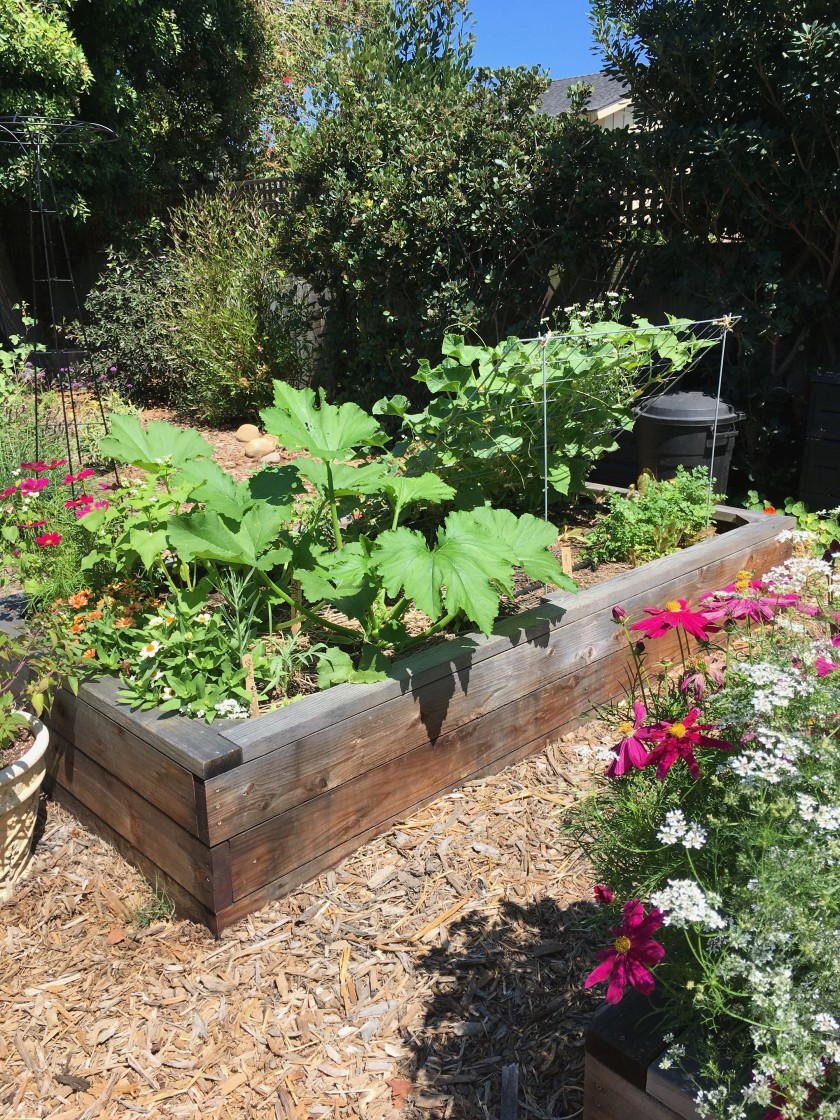Companion planting — folklore or scientific fact?

Large zucchini squash leaves help retain soil moisture, and cucumber vines on a trellis shield herbs like parsley and cilantro from the afternoon sun.(UCCE Master Gardener Joni Gabriel)
Botanical buddies from different species bring array of benefits to your yard, from pest defense to soil improvement
My Sicilian grandmother always planted basil next to her tomatoes. She claimed the basil made the tomatoes taste sweeter. Grandma never spent time in the library researching scientific articles on companion planting. Instead, she placed her trust in horticultural advice passed down through generations of family gardeners.
With dollars for agricultural research at a premium, there haven’t been many scientific studies to validate the efficacy of companion planting to improve the quality of the home vegetable garden. That doesn’t mean there isn’t some truth to the anecdotal history many of us have heard from our relatives and other longtime home vegetable gardeners. Recently, some universities have devoted time and money to study these long-held beliefs with interesting results.
Companion planting can provide many benefits for the home vegetable garden. It is defined as planting two or more species in close proximity to benefit one or more of the species — essentially, a type of symbiosis. Some companion plants provide shade; others attract beneficial insects, suppress weeds, repel pests, improve soil condition and may even improve flavor. Taken together, these attributes substantially contribute to creating a healthy organic garden and reduce the need for pesticides. For example, scented plants like rosemary, lavender, thyme, sage and marigold help repel some pest insects.

Flowers planted throughout a bed of lettuce — especially edibles such as pansies and calendula — attract beneficial insects and help control garden pests.(UCCE Master Gardener Joni Gabriel)
The concept of companion planting is an ancient one. Evidence exists that it was practiced in China and Egypt more than 1,000 years ago. In North America, one of the best examples of companion planting is the Three Sisters method. Centuries ago, early American colonists were surprised to find three different vegetables growing together in the same plot by Native American villages. This was a strange sight compared with the neatly plowed rows and beds of identical plants they saw in Europe. Native Americans planted pole beans, corn and squash together. This was an efficient use of available garden space, and each plant contributed something positive to the garden:
- Corn provided support for the bean vines as they grew.
- Beans, which have symbiotic bacteria on their roots, are “nitrogen fixers” (that change atmospheric nitrogen into a form plants can use). They added that essential nutrient to the soil, which benefits other plants, especially the corn.
- The squash leaves shaded the soil and helped retain moisture while discouraging vertebrate pests with its prickly leaves.
Native Americans saw these “three sisters” as precious gifts from the Great Spirit who watched over their crops and provided both physical and spiritual sustenance to the village. Scientists have not verified all of the claims of companion planting (for example, flavor improvement), but research does support the biodiversity benefits of this planting method.
In her book, “Plant Partners — Science-Based Companion Planting Strategies for the Vegetable Garden,” Jessica Walliser states that much of the recent information coming from universities and agricultural research facilities is leading us away from the long-held concept of companion planting, benefiting individual plant species. Instead, we should view the vegetable garden as an ecosystem with complex interactions among all the elements in the garden. Using plant partnerships to achieve a greater degree of overall balance in the garden is the modern way to implement companion planting. Plant partnerships can be used to:
- Improve soil structure and conditioning.
- Manage weeds, pests and diseases.
- Encourage biological control of pest insects.
- Improve pollination.

Marigolds and zinnias planted below squash that’s vining up a colorful ladder attract pollinators and other beneficial insects.(UCCE Master Gardener Joni Gabriel)
The goal of home vegetable gardeners is to have their own bounty of tasty, nutritious food free from harmful pesticides. Companion planting offers a way to help achieve this goal, but finding reliable information can be difficult. When faced with lots of conflicting information on companion planting, the best advice is to experiment, observe and record what works for you when you grow vegetables with different plant partners. When you look at your garden as a complete ecosystem, you will soon discover the benefits of using plant partners to improve results. And who knows — your tomatoes may even taste sweeter!
For additional information on vegetable gardening, visit the Master Gardener website. Get free gardening advice on the Master Gardener Hotline, (858) 822-6910, or by email at gro.ogeidnassrenedragretsamnull@pleh.
McClay has been a UCCE Master Gardener since 2018. She is an instructor in the Beginning Vegetable Gardening workshop teaching new gardeners how to create healthy and productive produce gardens.

